

Bloom et al Taxonomy of Educational Objectives. Implications Of Learning Theories On Instructional Design. Let's look closer at each learning theory, one at a time, explaining not only their definitions but also their implication on ID today.
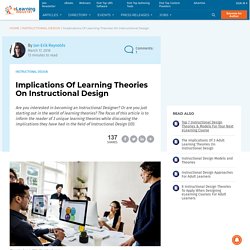
Behaviorist Learning Theory 1. Definition. 15 Learning Theories in Education (A Complete Summary) - TeacherOfSci. Best universities for education degrees. An education degree can open the doors to working and teaching in schools as well as carrying out research into how we learn.

Times Higher Education has ranked the best universities for education degrees to help you decide on the best university for you. Stanford University and Harvard University take the top spots in the ranking, with the University of Oxford taking fifth place. The University of Hong Kong is the only university in Asia to rank in the top 10, at number four, and the University of Cambridge rounds off the top 10. The remainder of the top 10 is dominated by US universities. US universities are well-represented in the entire subject ranking for education, with 118 universities. Canada and Australia are also represented in the ranking, with 19 and 33 universities respectively.
Times Higher Education subject rankings are based on the same 13 performance indicators used in the overall World University Rankings 2019. Best universities worldwide 1. 2. 3. 4. 5. Choosing the Right Learning Theory for Education. There are many learning theories in existence today, and they are developed by both teachers and learners.
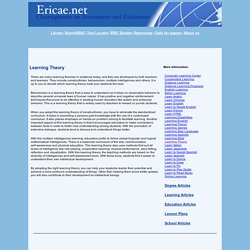
They include constructivism, behaviorism, multiple intelligences and others. It is up to you to decide which learning theory suits your students the best. Behaviorism is a learning theory that is easy to understand as it relies on observable behavior to describe several universal laws of human nature. It has positive and negative reinforcement techniques that prove to be effective in treating human disorders like autism and antisocial behavior.
The Five Educational Learning Theories. Educational Learning Theories While studying to become a teacher, whether in a bachelor's degree or alternative certificate program, you will learn about learning theories. There are 5 overarching paradigms of educational learning theories; behaviorism, cognitivism, constructivism, design/brain-based, humanism and 21st Century skills. Below, you will find a brief outline of each educational learning theory, along with links to resources that may be helpful. 1. Learning Theories and Models summaries - Educational Psychology. Metacognition. Metacognition is defined as "cognition about cognition", or "knowing about knowing".
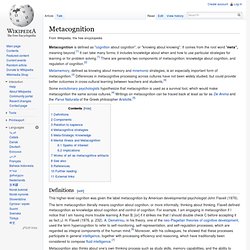
It comes from the root word "meta", meaning beyond.[1] It can take many forms; it includes knowledge about when and how to use particular strategies for learning or for problem solving.[1] There are generally two components of metacognition: knowledge about cognition, and regulation of cognition.[2] Metamemory, defined as knowing about memory and mnemonic strategies, is an especially important form of metacognition.[3] Differences in metacognitive processing across cultures have not been widely studied, but could provide better outcomes in cross-cultural learning between teachers and students.[4] Some evolutionary psychologists hypothesize that metacognition is used as a survival tool, which would make metacognition the same across cultures.[4] Writings on metacognition can be traced back at least as far as De Anima and the Parva Naturalia of the Greek philosopher Aristotle.[5] Definitions[edit] [edit]
Bloom's taxonomy. Bloom's taxonomy (cognitive) according to Bloom's verbs and matching assessment types.

The verbs are intended to be feasible and measurable. Bloom's taxonomy is a set of three hierarchical models used to classify educational learning objectives into levels of complexity and specificity. The three lists cover the learning objectives in cognitive, affective and sensory domains. The cognitive domain list has been the primary focus of most traditional education and is frequently used to structure curriculum learning objectives, assessments and activities. The models were named after Benjamin Bloom, who chaired the committee of educators that devised the taxonomy. History[edit] Columbia University in the City of New York.
Penn State-A Public Research University Serving Pennsylvania and the Global Community. The University of Chicago. World University Rankings 2018. The Growth of Visual Learning Infographic. Other Infographics The Growth of Visual Learning Infographic The Growth of Visual Learning Infographic Before there was language, we had images.
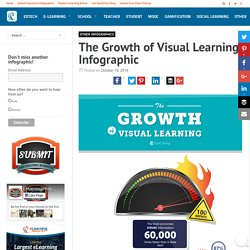
Though today we express ourselves through words and writing, our ancient ancestors would communicate through symbols and drawings. And despite the flexibility of thought that words given us, our brains are essentially image processors that are far more effective when working with visual information. Read also: Visual Thinking In eLearning: What eLearning Professionals Should Know. Culture, Curation, Contribution, Collaboration: The 4 Cs for Future Learning Organizations. You Say "Evolution," I Say "Disruption" Thousands of articles have been written in the last few years about the changes that are happening to learning within organizations.
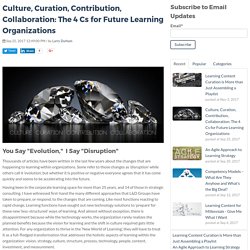
Some refer to those changes as ‘disruption’ while others call it ‘evolution’, but whether it is positive or negative everyone agrees that it has come quickly and seems to be accelerating into the future. Having been in the corporate learning space for more than 25 years, and 14 of those in strategic consulting, I have witnessed first-hand the many different approaches that L&D Groups have taken to prepare, or respond, to the changes that are coming. Like most functions reacting to rapid change, Learning functions have sought out new technology solutions to ‘prepare’ for these new ‘less-structured’ ways of learning.
Culture. Knowledge Management: Processes, Techniques, And Tools - eLearning Industry. Getting Started With Knowledge Management - eLearning Industry. In the last couple of years I’ve dealt with a few companies that were either unable or unwilling to preserve the knowledge and expertise of their employees.
This is a comment attached to Getting Started With Knowledge Management - eLearning Industry – slj3458
In fact, I was employed at one such organization for quite some time.
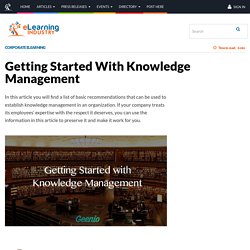
The company lost money and opportunities, and its image suffered as well, all due to the lack of a comprehensive knowledge management solution. In regards to training, the company put faith in the old “knowledge sharing is king” motto. However, they paid little more than lip service to the concept. In reality, it all boiled down to turning to a colleague when you were stuck, and if you were lucky, you got help.